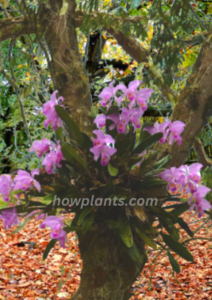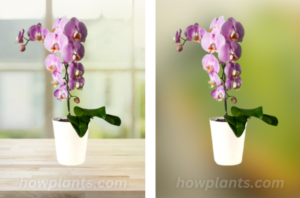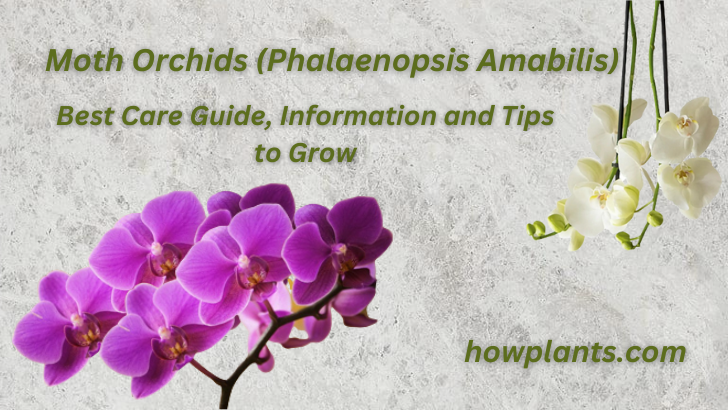Are you looking for the best tips and tricks on how to care for your orchid plants? Discover the secrets to successful orchid care! Having the right information on orchid care is essential to ensure they thrive in your home. In this article, we provide a comprehensive guide on how to properly care for an orchid from planting to maintenance. This guide provides an overview of orchids, including their history, basic care and maintenance tips, planting and potting to fertilizing and pruning. and how to identify different types.
Phalaenopsis Orchids also known as the moth orchid are one of the most beautiful, captivating and unique types of flower that, with the right care and attention, can be enjoyed for many years. They are prized for their exotic and colorful blooms, as well as the fact that they come in an astonishing variety of shapes and sizes. But growing a healthy orchid is no easy feat! With proper care and knowledge, however, it is possible to maintain a thriving orchid garden.
Biological History of Phalaenopsis Orchids
Biological history of this plant dates back to the 19th century. These fascinating plants have been admired for their gorgeous blooms and graceful form. Native to tropical climates in Southeast Asia and Australia, Phalaenopsis orchids have been cultivated since Victorian times for their exotic beauty. The majestic Phalaenopsis orchid, commonly referred to as the moth orchid, is a popular choice for those looking to add some beauty and elegance to their home. This genus of flowering plants consists of over 60 species and hundreds of hybrids that come in a wide array of colors and shapes. The first known collection of Phalaenopsis dates back to 1825 when French botanist Louis Auguste Deschamps discovered them on an expedition in Java. Since then, breeders have been working diligently to develop new varieties, making them accessible to a wider audience worldwide.

The beautiful blooms often last up to three months, making them an ideal flower choice for any occasion. In addition to being a symbol of luxury and elegance, these flowers are also known for their resilience as well as their ability to thrive indoors with proper care. The popularity of Phalaenopsis orchids has continued to grow over time due to its easy care requirements and stunning visual appeal. Whether grown in an indoor garden or used as a decorative accent in an outdoor space, these unique plants make wonderful additions to any home landscape.
How do Flowers of these Plants Grow?
To begin, they produce one stem with up to 8-15 blooms on each stem. The buds start out green and slowly develop into vibrant hues of pink, white and yellow – depending on the variety you have. As the buds mature, they will begin to open up gradually over a period of weeks until the flower is fully in bloom for several months. To ensure your flowers remain healthy during this time it’s important to provide enough light and humidity as well as regular watering.
Traits of these Plants
- The first thing you’ll notice about these plants is their large petals which can range in a variety of shapes from star-shaped to oval depending on the type.
- Their vibrant colors are also very captivating with common hues consisting mostly of pinks, whites and purples with other rarer shades like yellow being quite desirable too.
Are Orchids Indoor or Outdoor Plants
Unlike many other flowering plants, Phalaenopsis Orchids naturally grow in tropical climates where temperatures remain fairly consistent throughout the year. These plants are also accustomed to indirect light levels during the day and semi-dry soil conditions for most of their growing cycle. Thus, when kept outdoors – especially during colder months – these same factors can become adverse for its growth and health.
Optimum Temperature and Humidity Required
The optimal temperature for Phalaenopsis orchids range between 16°C (60°F) and 30°C (86°F). These plants prefer daytime temperatures within this range but can also tolerate lower nighttime temperatures of 10-15°C (50-59°F). It is important to keep in mind that if the environment is too cold, Phalaenopsis orchid buds may drop off before they have a chance to fully open. The optimal range of humidity for Phalaenopsis orchids is between 50-70%. While these plants will tolerate levels outside this range, they may have reduced blooming potential if not kept in their ideal environment. To increase the relative humidity around your Phalaenopsis try grouping several pots together on a pebble tray filled with water; misting regularly; using an electric humidifier; and adding a layer of mulch at the base of each plant.
Sunlight and Artificial Light Requirements
The optimal environment for Phalaenopsis orchids includes both natural sunlight and artificial light, but there is much more to consider when it comes to providing adequate care. To ensure your.
- Sunlight versus artificial light. Natural sunlight provides essential nutrients and energy for proper growth and blooming in Phalaenopsis orchids.
- However direct sun can be too intense so an eastern facing window with ample indirect light is ideal.
-
Where to Locate Orchids for Enough Light and Shade?
The best location for your plant is near a sunny window at least four feet away from the glass. This way, the plant will have access to plenty of light without being exposed directly to intense sunshine, which could damage its delicate blooms. To ensure that your orchid gets enough shade during the day, you can also hang sheer curtains over any windows it may be near.

Water Requirements
In general, these orchids need to be watered about once every 7-10 days. The exact amount of water will depend on several factors such as humidity levels, light, temperature and potting mix used. The best way to check if an orchid needs watering is to feel the soil with your finger; if it feels dry 2 inches below the surface then it’s time for a drink! It’s also important to avoid over-watering your plant which can lead to root rot and other problems.
Fertilizer Requirements
For these plants to reach their full potential, providing the correct fertilizer is essential.
The first step in understanding how to fertilize your Phalaenopsis orchid is knowing what type of fertilizer to use. A balanced 10-10-10 fertilizer is recommended by experts, applied every two weeks during the active growth period in spring and summer. During fall and winter months, when growth slows down, reduce application of the fertilizer to once per month instead.
Why and When to prune Phalaenopsis Orchids?
One critical step in taking care of a Phalaenopsis orchid is pruning. Pruning helps promote growth by removing dead leaves, flowers, and stems that may have been damaged due to pests or disease. It also encourages more blooms in the future.
Knowing when and how to prune a Phalaenopsis orchid is essential for successful maintenance of the flower. It’s important to wait until after the blooming period has finished before pruning because removing flowers from an active bloom will reduce the potential for future blooms on that stem.
Best Container for potting
When it comes to potting a Phalaenopsis orchid, you will need to consider the size and qualities of the container that is being used. A basic plastic pot with holes at the bottom is typically recommended for a Phalaenopsis orchid, as this allows for proper ventilation and drainage. A mesh insert should also be used inside the pot so the soil remains contained while still allowing water to drain out without clogging up the hole in the bottom. It should also be made from a material that retains moisture such as clay or terracotta, but must also have good drainage capabilities so excess water can escape. Aim for an 8-10 inch diameter container with several holes at the bottom for adequate drainage. The container needs to be tall enough so that when your Phalaenopsis plant begins to grow, it can still fit comfortably in the pot without becoming root bound.
Soil Composition and Requirement of bark chips for growth
Incorporating bark chips into your orchid’s soil composition can help create this ideal environment and provide the necessary nutrients for optimal health. Bark chips are an essential component of a Phalaenopsis orchid’s substrate; they contain slow-release nutrients that can promote healthy root systems and increase air circulation when mixed with other components like sphagnum moss. Moreover, bark chips are able to hold water longer than other substrates such as potting mix, which reduces the frequency of watering needed.
When repotting of Phalaenopsis Orchids should be done?
In general, best practice is to repot a Phalaenopsis orchid every one-to-two years. When selecting a new pot for your plant, make sure you choose one that has good drainage and is only slightly larger than the previous container for optimal growth.
Propagation of Phalaenopsis orchids
Propagating Phalaenopsis orchids is an easy, rewarding activity for all gardeners. Not only is it a great way to multiply your plants, but also to share and exchange with friends.
To start, you will need a healthy mother orchid and sterile cutting tools like pruners or scissors. You can make clones from stem cuttings of an existing plant as well as by using keikis—the baby plants that spontaneously appear on the flower spikes. Once rooted in soil or sphagnum moss, new growth should begin in just a few weeks!
Steps of Propagation of Phalaenopsis Orchids
- First, you must identify which part of the plant can be used for propagation. The best way to do this is by looking at the base of the spike and finding where it branches off into two canes—this indicates a good spot for cutting.
- Next, use a sharp blade and carefully make the cut about an inch below where it branches off.
- After cutting, dip the end in rooting hormone powder to increase its chances of survival when you plant it in soil later.
Different Types of Orchids
There are over 60 species of Phalaenopsis Orchids, each with its own unique characteristics. The most common varieties include the Moth Orchid, Nobile type, Ambrosia, Doritaenopsis and Oconee White varieties.
Disease and pests that harms the leaves of your Phalaenopsis orchids
While Phalaenopsis orchids can be relatively easy to care for, they are still susceptible to disease microbes that attack the leaves. These microbes cause discolored spots on the leaf surface and can quickly spread throughout the entire plant if not treated immediately. Knowing how to recognize and treat these diseases is an important part of successful Phalaenopsis orchid care.

Common pests that attack Phalaenopsis orchids include aphids, mealybugs, thrips, scale insects, spider mites, and whiteflies. All of these pests can cause damage to the leaves and even the flowers of your plant; if left untreated your Phalaenopsis may not bloom properly or die altogether. If you notice any signs of infestation it’s important to act quickly by removing any affected parts from the plant before cleaning with insecticidal soap or another suitable pesticide product.
Pesticides used against pests of Phalaenopsis Orchids?
There are several effective pesticides available on the market specifically designed to combat these types of pests in Phalaenopsis orchids. Some organic products such as neem oil have been successful in controlling infestations, while chemical insecticides like pyrethrins have also proven effective when used correctly. It is important to always follow directions on pesticide labels carefully for successful results and safety precautions.
Common problems of Phalaenopsis Orchids
One issue that commonly arises for Phalaenopsis owners is root rot. Root rot occurs when the roots become too wet due to overwatering, leading to yellowed leaves and stunted growth. Additionally, fungal infections such as brown spot disease can cause discoloration on the leaves which may require special fungicides for treatment.
- Wilting flowers and leaves
- Yellowing of leaves
- Wrinkled leaves
-
Causes of wilting leaves in Phalaenopsis Orchids
Wilting flowers and leaves of Phalaenopsis orchids can be an alarming problem for any gardener. Wilting is caused by either too much water or not enough water, incorrect humidity levels, temperatures that are too high or too low, or a combination of these problems. If you’re seeing wilted flowers and leaves on your Phalaenopsis Orchid, take steps to identify the cause and remedy the situation quickly.
-
How to cure wilting Leaves?
The right amount of water for a Phalaenopsis Orchid is key in preventing wilting. Generally, they should be watered once per week with lukewarm rainwater or distilled water until it starts dripping out from the pot’s drainage holes. During summers when temperatures are higher, one might have to increase the frequency up to three times a week depending on how fast the soil dries up.
-
-
Cause and Cure of yellowing of leaves of Phalaenopsis Orchids
Yellowing leaves on a phalaenopsis orchid can happen due to several factors including too much water, insufficient light or even lack of fertilizer. It’s important that you become aware of these causes so that it is easier to identify and address them if they arise in order to save your plant from any further damage. Ensuring that proper amounts of water, light and fertilizer are provided is essential in keeping your phalaenopsis healthy and vibrant while avoiding this issue altogether.
-
Why do leaves of Phalaenopsis Orchids become wrinkled? How to treat?
Wrinkling in Phalaenopsis orchid leaves is caused by too much water in the soil, which leads to root rot. This can be caused by overwatering, keeping the orchid in a pot that doesn’t have proper drainage, and/or leaving it exposed to cold temperatures. If the roots are damaged from water overdose, they will not be able to absorb enough nutrients from the soil for healthy growth. This causes the plant’s foliage to become weak and wrinkle up. This situation can be reversed by reporting the plant in the port that contains optimum water content and have proper drainage.
Dropping of Phalaenopsis Orchids buds without Blooming
In order for a Phalaenopsis orchid to flower, it must be given the right combination of light, humidity, temperature and fertilizer. Too much direct sunlight can cause buds to drop prematurely since this type of orchid prefers bright filtered light. If the environment is too dry, buds may also begin to wither away.

How to make Phalaenopsis Orchids to rebloom?
The key to making sure your phalaenopsis orchid reblooms is providing it with just the right amount of light and water. Make sure that when you water your plant, it gets enough moisture but isn’t saturated – this can cause root rot if done too often.

Conclusion:
Orchids are some of the most beautiful and diverse flowering plants on the planet, so it is no wonder why they have become such a popular choice for indoor gardening. To ensure your Phalaenopsis orchids remain healthy and thrive, it’s important to provide plenty of bright indirect sunlight and keep the soil evenly moist. Additionally, make sure you water them once every two weeks with lukewarm water—cold or hot water can damage the delicate roots system. This plant not only enhances the beauty around your surroundings but also is a stress relievers, makes the environment humid and helps in winter to avoid dryness and cough. So they are ornamental plants and besides this are best for our health.

2 thoughts on “Moth Orchids (Phalaenopsis Amabilis) Plant: Best Care Guide, Information and Tips to Grow for Beginners”